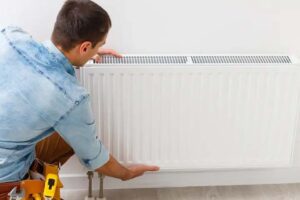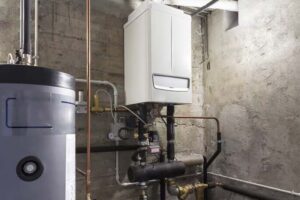Table of Contents
A boiler thermostat and controls are the powerful gadgets that your boiler needs to function. They work together to show the wonders of heating and cooling. These come in different sizes and shapes. And your combi boiler needs them to work properly.
This blog is your one-stop guide on your combi boiler thermostat and control. We’ll break down the essentials, so you can take control of your comfort and save energy and money along the way. So get ready to dive into the fascinating world of these tools.
Main components of boiler thermostat
Well, there are three main parts of this amazing device. All these team up to produce the desired results.
This incredible gadget consists of three primary components. Together, these all yield the intended outcomes.
- The Sensor: This monitors the room temperature continuously. Plus, it acts as the team’s eye in the back. If the temperature deviates from the desired level, it notifies the control unit via messages.
- The Control Unit: It gets input from the sensor. It chooses whether to switch on or off the boiler to maintain a comfortable temperature in the room. The team’s energy source, the power supply, keeps everything operating efficiently. An interface is also present, like an upscale control panel. This allows you to remotely control the temperature from your computer or phone. Or you may change it manually. Together, these features maintain the ideal temperature in your house. As a result, you can reduce the amount you pay for energy.
What’s boiler control?
This is the control panel that allows you to operate all of your combi boiler’s features, such as hot water and central heating. Usually, it consists of a thermostat. It then regulates your house’s temperature. Moreover, it measures the temperature of the air and communicates with the boiler to turn it on or off. An optional timer lets you set the boiler to come on and go off at particular periods of the day or week. First, you may want to install a smart thermostat if you don’t already have one. Then, another item to consider may be thermostatic radiator valves. By installing both of these technologies in your house, you may cut your annual energy bills by between £75 and £155.
Functions of boiler thermostat
This is the control centre for your heating and hot water. Utilizing it, you can:
| Functions of boiler thermostat | |
| Manually turn it on or off | When to turn on the heating or hot water is up to you. |
| Establish a timetable | Set the timer to automatically turn on and off the heating and hot water at predetermined intervals. |
| Perfect environment | Most homes work best at 60°C. Insulated homes: 50–55°C might be OK if your house is well-insulated. |
| Refer to the manual | To prevent setting temperatures too low, always double-check with the manufacturer’s instructions. |
Keep in mind that the water that comes out of your taps may not be the same temperature as the one you set on the thermostat. To change the final water temperature you use, they have different options.
Room Thermostat
It is a little sensor that resembles a silent guardian on your wall. Typically, it is located downstairs rather than next to your boiler. There are two versions available:
- Analogue: You may adjust the desired temperature with this traditional style by turning a dial. Digital: This recent option is more precise. It frequently includes capabilities like programming and timers.
Your room thermostat operates as follows:
It continuously measures the temperature within your house.
- Communicate with your boiler: It instructs the boiler to turn off the heat when the room reaches the appropriate temperature.
- Maintains equilibrium: When the temperature falls, the boiler gives the signal to start up again, guaranteeing a secure atmosphere.
Why is this important?
- Comfort: Nobody likes to be hot or cold in their own house. Health: Extreme temperatures can be dangerous, especially to those who are more susceptible.
- Savings: You can reduce your energy costs by avoiding overheating. So, don’t forget to maintain the room thermostat and other boiler controls in good operating condition. It’s a tiny gadget that has a significant effect on your wallet, safety, and comfort!
Boiler Timer
A boiler timer, often known as a programmer, functions similarly to an intelligent scheduler for your hot water and heating. You can program in advance when you want them to turn on and off. As a result, you can have more control over your comfort level and energy costs. The controls you may encounter are broken down as follows:
The auto option is similar to “set it and forget it.” The timer does the rest; you just program the times you want your hot water and heating to run.
- On (or 24 hours): This might be costly and superfluous since it keeps your hot water and heating systems running nonstop. So use it with caution!
- Off: Completely stops your heating and hot water until you choose a different setting.
- Booster (optional): Great for those unforeseen chilly mornings, this add-on provides an extra boost to your heating or hot water beyond your set timetable. But remember every boiler is unique! To be clear about instructions and to get specifics, always consult your manufacturer’s handbook. You may program your boiler timer to heat your house in a way that is both comfortable and economical with energy.
How does a boiler timer work?
Like a nice alarm clock, your boiler has a timer. Alternatively, you can program it to switch on and off at particular times of the day, such as in the morning and evening. Actually, this is preferable, particularly if your house has adequate insulation. When the boiler shuts off, the heat continues to run for a time. Consequently, it allows you to leave your house throughout the day and come home to a warm house. This saves costs and energy! You can have separate heating settings for the weekdays and the weekends with these timers. Additionally, some boilers—particularly combi models—have a more basic timer, such as a dial with notches. So if you need a quick heat boost at any time, even when it’s not in the regular schedule, pull the notches down.
Advanced Tips
Here are a few short ideas to keep your house cosy and reduce your heating costs:
- Keep your room’s thermostat away from sources of heat: Place it away from furniture, radiators, and your furnace as these could interfere with its readings.
- Establish a heating schedule: Set up your boiler so that it only runs in the morning and evening. Maintain hot water at 60°C to help stave off the dangerous illness known as Legionnaires’ disease.
- Reduce the temperature a little bit: Even a 1°C drop will help you save money.
- Adjust individual room temperatures: Use transistor radiator valves (TRVs) to regulate the temperature.
- Assign numbers two and three to the bedrooms and other rooms.
- Establish an appealing temperature in your room: aim for 19–20°C, but don’t go below 16°C, especially if you have senior citizens living with you.
Thermostatic Radiator Valves
Do you want even greater heating control? If you have radiators, you might want to add thermostatic radiator valves (TRVs). You can manually control the temperature in each room using these ingenious devices. This is how they function:
Every radiator has a unique TRV, typically with numbered settings ranging from 1 to 5. In that particular room, raising the dial raises the temperature, and lowering it lowers it. The precise temperature will vary depending on how hot the water was when it first reached the radiator.
A helpful general rule of thumb is that a comfortable room temperature of about 20°C is frequently achieved by setting the TRV to the middle (number 3).
Saving using TRVs
Although we don’t advise totally shutting off radiators in unoccupied rooms, you can reduce your energy costs by setting their TRVs to 1. In this manner, you can save needless energy waste by simply heating the rooms that you really use. Recall that TRVs operate best when the thermostat and boiler are in good working order. When combined, they may produce a heating system that is both cosy and economical for your whole house.
Why do you need a thermostat for a boiler?
A thermostat for a boiler is the basic requirement. Without it, temperature control could not be possible. Furthermore, since 2018, it has been a legally mandated condition for all new boilers in the UK. This is the reason why:
| Why Need a Thermostat | |
| Temperature control | It allows you to change the hot water and heating temperatures. As a result, it eliminates wasteful energy use and maintains comfort in your house. |
| Requirement under law | For all newly installed gas and oil boilers, Boiler Plus regulation requires temperature and timing controls. |
| Efficiency of energy | You can reduce your energy costs by using a properly operating thermostat. Plus, it’s a financial investment that might help you save money. |
Consider replacing your outdated, non-thermal boiler with a modern, compliant model if you have an older boiler.
How does a combi boiler thermostat work?
Most boilers come with two built-in thermostats to regulate these distinct functions. The heating thermostat regulates the water temperature that goes to your radiators. Moreover, it controls the general temperature of your living space. Next, the hot water thermostat controls the temperature of the hot water that runs through your shower and taps. Combi boilers are popular for their efficiency and small size. They do not require a separate hot water storage tank because they heat water straight from the mains.
The following summarizes combi boiler thermostats:
Two built-in thermostats
Thermostat for heating: Regulates the water flow temperature to radiators.
Thermostat for hot water
Controls the hot water temperature for showers and faucets. Location and look: The boiler unit’s dials or you can usually use buttons. On more recent models, you can incorporate it into a control panel or digital display. For precise information, therefore, always consult the boiler handbook. You can manage the heating and hot water in your house efficiently if you know how to use the thermostats on your combi boiler. This guarantees a cosy and energy-efficient atmosphere as a result.
How do I connect a thermostat to a boiler?
It is advisable to hire an expert to perform the actual installation of a thermostat. They will guarantee both safety and accuracy. You can select a wifi or smart thermostat after installation.
Wireless thermostat
- Activate the wireless network.
- Verify that the thermostat receives a signal and that the receiver is operational.
- Now, install the thermostat-compatible app on your phone and link it to your boiler.
Smart thermostat
- Completely cut off the electricity to your central heating system.
- Using the included wires, connect the thermostat to the hub and your internet.
- Connect the hub to a power outlet.
- Keep the receiver away from anything that could interfere with the signal but close to your boiler.
- Never forget to carefully follow the manufacturer’s instructions to prevent issues and maintain the validity of your warranty.
- To ensure its smooth installation, you better consult a professional installer.



